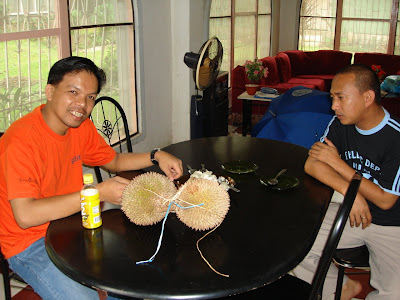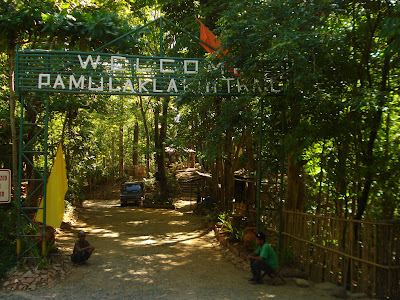Our original plan was to go to Tawi-tawi because we heard that there are beautiful white beaches there and the place is a bit safer than Jolo or Basilan. However, the religious sister that would accompany us there was waiting for us in Jolo as she had to submit the final reports of her apostolate there. She invited us that we first go to Jolo, at least to see the place even for just a few hours before taking the fast craft for Tawi-tawi. There were three of us who daringly took the adventure: Fr. Mony Calubid, Ronnie Ramirez, our computer wizard friend and myself. We took the plane from Cebu to Zamboanga and then boarded the boat in the evening for Jolo. The boat was filled to capacity and we only had cots without beddings. We were with a catechist whom Sr. Betty asked to accompany us on this boat trip to Jolo. Naturally almost all the passengers would be Tausug Muslims. Later during the night, our companion had us transferred to another place in the boat. We would be informed after that there were some people who were supiciously eyeing us and were asking questions about our presence. Of course we were not aware of this and we could not understand a thing as they were speaking in Tausug. They were told by our companion that we were invited teachers at the Notre Dame College in Jolo. Apprehensive of our situation, she had us transfer to another place in the boat. Kidnapping in Jolo of Christians is just an ordinary occurrence.
When we arrived in Jolo early the following morning, the first thing we noticed was the heavy presence of the military. My feeling was that we were in a war zone. Sr. Betty was there at the port to meet us escorted by some Marines. We were told that the marines are serving as security guards of the Notre Dame school and the surrounding compound which includes the bishop’s house, the Carmelite monastery and the house of the OMI fathers. Early that morning we proceeded to see the new capitol of Jolo which has become a promenade of the people there, as it is beautifully landscaped and well lighted. We took some pictures of the place. I remember asking our marine escort to join us for picture which he refused when he noticed that there would only be three of us posing for the camera. Being in a life-threatening situation all time, even superstitious beliefs are taken seriously. Next we went to a nearby restaurant to taste their delicacy called “sate”. It is rice cooked in coconut leaves (puso) and barbecued beef floating on a special kind of sauce orange in color.
Passing through the thoroughfare of Jolo, you could hardly miss the presence of military and its threatening air. There were plenty of road blocks and heavily armed military personnel. It just felt different. We were told that the military there are composed of the Marines, Army and Air force. Add to that were the American balikatan forces that are embedded in these three military brigades. We were late for the mass at the Carmelite monastery but we met the sisters there and Sr. Pamette, OND from Tolosa.
As we were having another breakfast at the bishop's residence, it started to rain hard with strong winds. There was a typhoon but it was raging only in northern Luzon. Yet even up to the southern Philippines in Jolo, the effects was being felt that day. We were supposed to take the Weesam fast craft which was coming from Zamboanga in going to Bonggao, Tawi-tawi. Our apprehension was realized when we were informed that the Weesam was not able to leave Zamboanga. That meant that our trip to Tawi-tawi would be canceled. We tried calling the airport if there was a plane that day or the following day leaving for Tawi-tawi. There was none. And so we had a whole day stay in Jolo going just to places the marine escort deemed safe enough. This included the Cathedral of Jolo and beside it the tomb of Bp. Bienvenido de Jesus who was gunned down just near the church. In the evening we took again the boat to go back to Zamboanga since we could not proceed to Tawi-tawi.
We decided that from Zamboanga we will go to Basilan and go to the equally famous white sand beach of Malamawi. Malamawi is an island just across Isabela City, the capital of Basilan. It has beautiful white beaches at the other side of the island. We first visited the Cathedral in Basilan and asked somebody to guide us to Malamawi. A lay minister accompanied us. The priest also warned us that the peace and order situation in the island is volatile and so asked that we just be careful. There are only few Christian settlements in the island of Malamawi and you could right away guess because of the presence of pigs. Sr. Betty had to take off her veil and don ordinary dress. Although it was not raining, the skies were dark because the storm was still raging up north. Dark clouds and threat from lawless Muslims however, could not dampen our spirits as we gleefully took to the sea.
 The marines are the ordinary escorts and guards of the government officials and the different establishments especially of Christians in Jolo.
The marines are the ordinary escorts and guards of the government officials and the different establishments especially of Christians in Jolo. This is the entrance to the Notre Dame College and within the compound is the bishop's residence, the OMI house and the Carmelite monastery. The security outpost is secured by burbwires.
This is the entrance to the Notre Dame College and within the compound is the bishop's residence, the OMI house and the Carmelite monastery. The security outpost is secured by burbwires. The Cathedral of Jolo.
The Cathedral of Jolo.
 Just beside the Cathedral is the tomb of the martyred Bp. Bienvenido de Jesus.
Just beside the Cathedral is the tomb of the martyred Bp. Bienvenido de Jesus. The bishop's residence. We were told that there are only three parishes in the whole vicariate of Jolo which composed of the two provinces of Jolo and Tawi-tawi: Jolo, Siasi and Bongao, the capital of Tawi-tawi. Christians comprises only about two to three percent of the whole population. Most of the inhabitants of Jolo are Tausugs while that of Tawi-tawi are Samals and Badjaos. They say that the Tausugs are the aggressive type of people while the Samals and Badjaos are peace loving.
The bishop's residence. We were told that there are only three parishes in the whole vicariate of Jolo which composed of the two provinces of Jolo and Tawi-tawi: Jolo, Siasi and Bongao, the capital of Tawi-tawi. Christians comprises only about two to three percent of the whole population. Most of the inhabitants of Jolo are Tausugs while that of Tawi-tawi are Samals and Badjaos. They say that the Tausugs are the aggressive type of people while the Samals and Badjaos are peace loving.


Ronnie and Fr. Mony enjoying durian which abound in Jolo. Picture below is a durian tree.
 The new Capitol of Jolo. This has become a place for promenade by the people. In the evening the place would be filled with people who go there as the place is well lighted, beautifully landscaped with fountains.
The new Capitol of Jolo. This has become a place for promenade by the people. In the evening the place would be filled with people who go there as the place is well lighted, beautifully landscaped with fountains.


 Sate, the delicacy in Jolo, usually served for breakfast.
Sate, the delicacy in Jolo, usually served for breakfast.
PICTURES FROM BASILAN AND MALAMAWI BEACH


 The Cathedral of Basilan
The Cathedral of Basilan With the priest at the Cathedral who helped us looked for a guide to go to Malamawi beach. He warned us just to be careful, you never know just when the violent elements would make their move.
With the priest at the Cathedral who helped us looked for a guide to go to Malamawi beach. He warned us just to be careful, you never know just when the violent elements would make their move. Most of the Badjaos still live by the sea on stilt houses. They say that the Tausugs mostly of Jolo still look down on this tribe calling them tao-luwaan.
Most of the Badjaos still live by the sea on stilt houses. They say that the Tausugs mostly of Jolo still look down on this tribe calling them tao-luwaan. Taking the boat in a ten-minute crossing to Malamawi from Isabela City wth Sr. Betty.
Taking the boat in a ten-minute crossing to Malamawi from Isabela City wth Sr. Betty.
 Getting off the boat upon reaching Malamawi we still had to ride in a tricycle as the white beaches are on the other side of the island.
Getting off the boat upon reaching Malamawi we still had to ride in a tricycle as the white beaches are on the other side of the island. 


 The fine white sand beach in Malamawi.
The fine white sand beach in Malamawi.
 Fr. Mony
Fr. Mony Ronnie
Ronnie
 One of the delicacies in Jolo. Sold also in the market were turtle eggs.
One of the delicacies in Jolo. Sold also in the market were turtle eggs.




































